Florida Gigs & Vacation
(Note: Clicking on any image in this travelogue will bring up a full screen version of the image.)
Saturday - Monday, February 22 - 24:
Gigs
This all started in 2010, when I received a CD order from a fellow named Paul Wales in Gainesville, Florida. He had heard my music on the radio somewhere. And he told me he ran a house concert series there, and if I ever had the notion to perform in the area, I should give him a call. So when in June of 2019, I thought to maybe try to do that, I searched my mailing list database for folks in Florida (I keep geographic data as well as email addresses), and his record popped up, along with that entry in the "Random Notes" field. I called him up, and he remembered me. And he agreed to the general idea, although it was his wife, Annie Orlando, who was the real organizer of the series, which was called "The Thirsty Ear". (An obvious reference to "The Hungry I" folk club in San Francisco in the early 50s.) She agreed wholeheartedly, and so we agreed in principle that this would be the anchor gig of my tour. (Sounds impressive, doesn't it?) We settled on the general time frame of February or March 2020
So I went about looking for other contacts within a reasonable distance from Gainesville to put together a mini-tour of 2 or 3 gigs to make the trip worthwhile. There was Gloria Holloway, whom I had met at the SERFA conference in Asheville, NC in 2015. She is a tiny woman in her 70s with boundless energy, and a mover-and-shaker in the folk scene in Tampa. And I looked around in the Listening Room Network website for a third gig. This is sort of an Internet yenta organization, matching up house concert hosts with touring performers. And I secured a booking in St. Petersburg, just across the bay from Tampa with Fran Snyder, the founder of LRN. So we settled on "The Thirsty Ear" on Saturday, Feb. 22, "South Tampa House Concerts" with Gloria on Sunday the 23rd, and "Ringo's House Concerts" (named after Fran's dog) with Fran on Monday the 24th.
Then I thought to myself, "February in Florida?" Seemed a shame to go down there and come back without taking advantage of the southern clime in winter. So I called up my friend Jenny, and asked if she wanted to take a few vacation days in Florida. Sounded good to her. Jenny and I have a good relationship for vacations. I do all the driving, and she does all the planning. So she lined up where to stay and where to go. She'd fly down to meet me in Tampa after my gig on Sunday, and we'd be tourists for a few days, and go back home on Thursday.
The flight down to Gainesville was largely uneventful with one minor exception. I generally schlep my guitar with me through the airports, with the hope of bringing it on board with me and putting it in the overhead compartments. And if there's no room, I gate check the instrument, leaving it at the door of the plane to be picked up by baggage handlers and loaded into the baggage compartment. I have a good flight case for it, and the major opportunity for damage in checked baggage lies mostly in the belts and carts and forklifts it encounters between the place where you drop off your checked-in bags and the plane, not in the short hand-carried trip between the jetway and the baggage compartment. So I got to my seat in the plane, and was casually observing out the window, watching the baggage handlers moving the various gate-checked items into the hold. There was a short conveyor belt that carried the suitcases and baby carriages from the jetway to where the baggage handlers would receive the items, and carry them to the plane. The exit end of the conveyor belt was about chest-high, which made it easy for the workers to pick up the items. As I watched, a suitcase made its way down the belt, but there was no one to receive it at the time. I figured there would be an electric eye to stop the belt in such situations. But no, the suitcase blithely proceeded off the end of the belt, and dropped 4 feet to the ground. And I began to worry. Sure enough a few minutes later, there came my guitar down the belt, and, to my horror, there was no one there to receive it. I frantically fumbled for my phone to try to take a video of the impending disaster. But before I could get it out along came a crewman, and picked it off the belt. Whew!
The Thirsty Ear gig went well. The crowd was smaller than expected due to other events happening in the area. But I was well received, and made some CD sales, which have generally been pretty thin over the past few years. My plan was to rent a car in Gainesville on Sunday, and then return it in Tampa when I flew home on Thursday. But I discovered there were huge fees for returning the car at a location other than where it was rented. It surprised me, because I had done just such an operation with the same rental company on my Southwestern vacation in 2017. In the end, I wound up paying Paul and Annie's son $100 to drive me to Tampa.
The concert in Tampa was to be held at the home of Gloria's boyfriend Craig, just a block from Gloria's house. That went well also, and with a bigger crowd. As it turned out, however, it was to be Gloria's last concert for the foreseeable future. She'd had a rough year, losing both her sister and her mother (at age 100), and was experiencing some health issues herself. So she's putting her series on hiatus for the indefinite future. The show went great, however, and was attended by another house concert host who was well impressed, and offered me a gig sometime down the road. The evening was punctuated by two incidents that happened after the show. First, Craig's dog, Dexter, a completely undisciplined mutt, got loose, and Craig spent two hours with a flashlight chasing him around the neighborhood, and eventually corralling him back home. And then, my plan was to use Gloria's car to pick up Jenny from the airport, where she was due to arrive around midnight. I thought she was going to call me when she landed. So I figured I'd lie down and take a nap, and be awakened by the phone. Well, I woke up on my own around 3:00AM to discover Jenny asleep on the other bed in the room. There was a miscommunication somehow, and she never called me, but wound up taking a taxi to Gloria's.
We had more misadventures picking up the rental car the following morning. It seems the rental counter at the airport is not intended to be used by people not arriving by plane. So we had to drive Gloria's car to the airport parking lot, walk through a lot of places not really intended for foot traffic, and get to the rental counter inside the terminal. And then with me leading the way in the renter, and Jenny following in Gloria's car, I set the GPS for Gloria's address on Ohio Avenue. But it seems that there are two Ohio Avenues in Tampa, and of course the GPS led us to the wrong one. However, that wrong one brought us by the Tampa Aquarium, which gave us a good idea for something to check out later in our trip.
We had some time to kill before arriving at the Ringo's venue. So we stopped off at Weedon Island Preserve and wandered around for an hour or two. Nothing in particular to relate or photograph there, but it was very pleasant to wander the boardwalks over the wetlands in shirtsleeves in February. We arrived at Ringo's well in time for dinner. Unlike most house concerts, this one was held in an apartment. It was situated in a lo-rise block in the heart of downtown St. Petersburg. The attendance was small. The capacity of the room is only 16, so I didn't expect a mob. But Fran was a gracious host, and everyone there seemed to enjoy themselves.
Tuesday, February 25:
Sunken Gardens and Imagine Museum
So Tuesday morning, we headed off to the Cordova Inn, our home for the next three days.
This is one of the many reasons why I love it that Jenny does all the planning on our vacations. She finds places like the Cordova Inn. She calls it "shabby genteel". I wouldn't go so far as to call it "shabby", but it definitely lacks the antiseptic feel of a typical modern hotel. Built in 1921, and fully restored in 1999, it is the oldest hotel in St. Petersburg. And, while not quite up to Great Gatsby standards, it s definitely high on charm and character. We got an electronic passcard to get in the front door after 10:00 PM, but a real key to open our room door. It's not ADA compliant; it has 12-foot ceilings, which makes the walk-up access to the 2nd floor room a considerable walk up. The bed was comfy, and the WiFi fast, but the room door took a healthy shove with a shoulder to open, and only one of the windows would open at all. There was a very classy lobby with overstuffed furniture and a fireplace, but the free "continental breakfast" left something to be desired. You get the picture.
|
|||
The Cordova let us check in early, and we had most of the day to kill. So first on Jenny's itinerary was Sunken Gardens. This is one of oldest tourist attractions in Florida. The 4 acre site started as private nursery and fruit garden, and was opened to the public in the 20s. It reveals its heritage by way of the sign out front, in the style of a 1950s motel. It got its name because the lowest point of the site started out as a shallow lake 10 feet below sea level. It is currently owned by the City of St. Petersburg, and contains a building on the National Register of Historic Places.
The site is crisscrossed by a labyrinth of intertwining and intersecting paved trails (Photo 30) that thoroughly confuse and lose the visitor. And this visitor didn't care a whit. The place is so beautiful I could be lost in it forever. It is beautifully landscaped and filled with flora and fauna, both indigenous and foreign, The flamingos (Photo 100), for instance came from Chile. The koi (Photo 120), a species of giant carp, came from Japan. (Funny. In person you could see them very clearly. But the reflections off the ripply surface of the pond were much more prominent in the photo.) The bougainvillea (Photo 40) are native. Their blooms are so pink, and so fluorescently brilliant that they seemed to be wasting electricity just sitting there. I was at first unable to identify the big palms or ferns or whatever in Photo 50. Amy Hopkins tracked them down as Giant White Bird-Of-Paradise from South Africa. ( I said "What? They are neither birds or white, and 'giant' is a matter of opinion." She told me that in season they bear Bird-Of_Paradise flowers. Oh.) The turtle (Photo 130) was native. They also had native alligators, but they were too reclusive for me to get a good photo. The macaws (Photo 140) and cockatoo (Photo 150) were probably from somewhere in South or Central America. The blue macaws side by side in the background of Photo 140 amused themselves and us by rocking their perch from side to side over a pretty wide arc like kids sitting sideways on a see-saw. I tried to get a movie of them doing that, but I hadn't used my camera in so long that I forgot the procedure of how to use it as a movie camera.
We spent a few delightful hours wandering the place, and then drove back to the Cordova Inn, and had some lunch. It was a short drive to our next stop on our itinerary, the Imagine Museum.
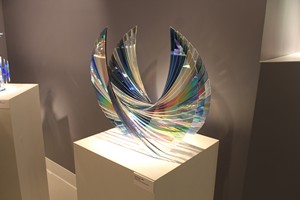 240. Bird of Paradise |
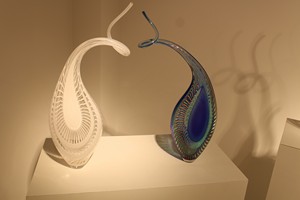 250. Swans |
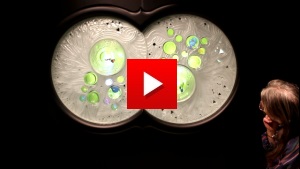 260. Kaleidoscope (video) |
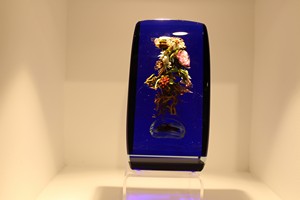 290. Flower Arrangement |
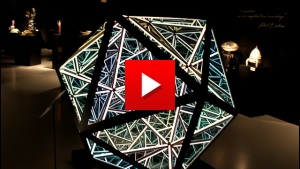 300. Dodecahedron (video) |
The Imagine Museum turned out to be one of those big delightful surprises for me. I'm usually pretty ambivalent about art museums. And this one is a museum of contemporary glass art from 1960 forward. And it was two floors of mostly jaw-dropping beauty. It was hard to respect the "Do not touch" signs all over the place. I was less prepared for this attraction than is my wont, and did not come equipped with notepad to take down the official title and artist of each piece. In the descriptions below, I've referred to the high resolution original images to provide that information if the title card appeared in the photo. My apologies to the creators of the pieces whose photo did not include the tag.
180. Jenny Under Glass: A couple of large prisms cast (I suppose) together.
190. Faux 3-D: This piece, which appears to be very deep, is only about 3/4 of an inch deep or so. The back is a mirror, and the front surface is half-silvered, or treated in a similar fashion such that the stuff between them is repeatedly mirrored and duplicated ad infinitum.
200. Vessels: Not much to say about that, other than they are beautiful.
210. Da Vinci's Man: ("Vitruvian Visions", Tim Tate. Cast glass, plate glass, mirror, steel, LED lighting) Another one like Photo 190 with a mirror back and a half-silvered front glass repeating the stuff in between with the illusion of depths.
220. Sphere in Cube: (Sorry, the card is in the photo, but it's out of focus and I can't make out what it says.) This one is particularly fascinating, because the dotted circles on the surface of the sphere when viewed through the face shown in the photo resolve themselves into vertical red lines when viewed through the side face.
230. Directional Distortion: ("Lentilus", Petr Nora) Jenny was fascinated at how the proportions and shape of her hand changed, depending upon its orientation.
240. Bird of Paradise: ("Wings", Tom Marosz, Polished and laminated glass) Many thin plates of identically shaped, but differently colored pieces of glass laminated together.
250. Swans: Again, no comment other than to remark on their beauty.
260. Kaleidoscope: I called this one Kaleidoscope because the greenish circles are (I believe) lenses looking into a tank behind the piece full of some sort of oil, in which various pieces of colored plastic are suspended. The oil appears to be agitated slowly, because those pieces drift into and out of the view of the lenses, giving the same impression as one would get looking into a kaleidoscope. Also, the greenish color slowly changes as different gels, physical or electronic, are used to illuminate the oil. Check out the video. (Oh, and that chattering noise you hear during the video is the auto-focus of the camera lens refocusing as the distance between the camera and the subject changes.)
270. Rotating Cube: (Again, the info card on this is out of focus, and I can't read it.) Self-explanatory.
280. Mermaid: ("Cabriole", William LeQuier, Laminated, sandcarved glass).
290. Flower Arrangement: Just to give you an idea of the scale, this one is about 10" high as I remember.
300 & 310. Dodecahedron: ("Portal Icosahedron", Anthony James, Titanium and specialized glass) To me, this was the piece de resistance of the whole museum. The piece is about 5 feet high, and lit through the bottom facet, which you can't ever see, because it would only be viewable through the top facet, which is too high to look directly down through. The facets are of half-silvered glass, which turns them into mirrors when viewed from the bright interior to the dark exterior. That produces the same type of repeated image ad infinitum as "190. Faux 3-D" above, except that you get one set of repeats from each of 10 pairs of parallel facets in 10 different directions. What makes it especially striking is that the skeleton is brightly lit on the inside from the illumination through the bottom facet, but dark on the outside. Take a look at the video and note what happens as your view passes directly perpendicular to a facet, viewed through the very center of the facet. I am impressed at how accurately the facets must be aligned to get opposite faces precisely parallel to each other such that the view down to infinity is straight, rather than veering off in one direction or another.
Wednesday, February 26:
Chihuly Collection and Fort DeSoto
Today's plan was to visit the Chihuly Collection, another glass art museum featuring exclusively the works of Dale Chihuly in the morning. And then in the afternoon, drive to Fort DeSoto at the very southern tip of the St. Petersburg peninsula, and walk on the beach. After all, we're in Florida, for goodness sake; we gotta do something by the water!
I don't know if St. Petersburg, Florida is a Mecca for glass art. And I didn't know that Jenny had such a penchant for the subject. But that was on the agenda for this morning. And I so enjoyed the Imagine Museum that I was keen to go. One of the convenient things about the Cordova is that it's situated right in the heart of town within walking distance of a lot of the attractions of the city. So we set off, strolling through downtown St. Pete, and looking at the sights. We walked past the '20s-elegant Town Hall, (Photo 350) built of local limestone. We could assume it was local (or maybe Jenny knew that), as there were fossilized sea creatures in the very masonry of its construction (Photo 360). There were various pieces of street art (Photo 370) along our route. And in 15 or 20 minutes, we arrived at the Chihuly Collection building (Photo 380). The building was purpose-built to house the Collection under the auspices of the Morean Arts Center. I was not familiar with Dale Chihuly, but evidently he is an internationally known figure in glass art.
Well, if the Imagine Museum was a delightful surprise to me, the Chihuly Collection was a disappointment . His stuff didn't really appeal to me. I can't say why. It was certainly pretty, and undoubtedly skillful in its creation; just not to my taste. (Photos 390 and 400 for examples) The exhibit was much smaller than the Imagine Museum, and mostly of larger pieces. It took us maybe 20 minutes to view the entire Collection. And the admission price was double that of the Imagine Museum, where we spent several hours. There was a video of Dale himself and a number of his students constructing a huge outdoor installation in Jerusalem several years ago. The process of creating and constructing the installation from pre-prepared pieces was mildly interesting to me, but again, I didn't really care for final installation. What did make the visit worthwhile to me was an extended demonstration of glass-blowing, included in the ticket price, at a workshop associated with the Collection across the street and a block away.
We had been alerted to get to the glass blowing workshop at least 10 minutes before its scheduled noon start time, so we bugged out of the video a little before it ended, and walked over to the workshop. We were led into a big open high-ceilinged room with bleacher seating for maybe a hundred observers. Along the far wall, about 40 feet from us, were a number of ovens putting out a prodigious amount of heat, even though their doors were closed. Overhead were three multi-bladed paddle fans about 8 feet in diameter rotating slowly. Despite the fans and the fact that the left wall was open to the outside air (about 65 °), it was still uncomfortably warm in the room. In the foreground were several steel tables and racks containing blowpipes, tongs, and other tools and equipment to be used during the demonstration.
Two artisans, David and Edelweiss, came out and began the demo. David was to perform most of the lead work at this demo, and Edelweiss served as his assistant and play-by-play announcer. But they switch roles on alternate demonstrations. They were obviously an experienced and well rehearsed team, as they performed all their tasks smoothly with no verbal communication between them, in quick, almost choreographed collaboration. It soon became obvious that this was necessary, because the oven temperatures were over 2,000°F, and the glass had to be worked quickly before it cooled and stiffened.
I had intended to make a complete photographic record of the procedure. But not knowing in advance what was going to happen, how many steps it would take, or what was important in the process, I missed a number of important steps. (I hate to be one of those guys for whom the photography is more important than absorbing and enjoying the subject matter first hand.) So the sequence of photos above is more of a sampling of the procedure, rather than a complete record. The whole procedure took about 45 minutes or so. And I never got a photo of the final product, because it had to be quickly placed in an annealing oven, where the temperature would be brought down from around 1,500° to closer to room temperature over the course of many hours to prevent the piece from cracking from thermal stress.
We walked back to the Cordova, taking a detour to circumnavigate Mirror Lake (Photo 470), adjoining a little park across from City Hall. The big turtles (Photo 480), ibises (ibes? ibi? Photo 490), and banyan trees (Photo 500) are among the numerous fauna and flora I don't often see back home in New Jersey.
After lunch, we hopped into the car, and drove out to Fort DeSoto State Park at the Southern tip of the St. Petersburg peninsula (See map) to walk the beaches of the Gulf of Mexico. Well, that turned out to be a bust. You'll notice the pink umbrella Jenny is carrying in photo 500. Well that turned out to be unnecessary until the afternoon. As we drove out, it started to drizzle. It was about a 20 mile drive, mostly through over-developed commercial property and across a number of toll bridges, as the rain grew steadily harder and more insistent. And when we finally got to the park, it was coming down hard and steady, and we discovered there was an entry fee. Coming to the realization that we would not be getting sand in our toes this day, we turned around and went back home to the Cordova. We stopped for a few minutes by a pier, and watched a bunch of pelicans diving for fish. That was entertaining. I tried to get some movies of them in action. But between the suddenness of their dives and the rain on the windshield (I didn't feel like getting wet to go out and film them.), I couldn't get any decent shots.
Back across the toll bridges to the Cordova, and a block's walk to a local pizza joint for dinner.
Thursday, February 27:
Florida Aquarium, and home
My flight home was scheduled to leave Tampa Airport at 6:10PM, and Jenny's about an hour earlier. So we figured a good plan would be to visit the Florida Aquarium that we spotted on our misguided GPS journey to the wrong Ohio Avenue in Tampa.
Wow! What a good idea that was. It fit very nicely in our travel plans, as the Tampa airport was only a half hour or so from the Aquarium. We checked out of the Cordova Inn, and drove back to Tampa and parked at the Aquarium. I'm usually uncomfortable about leaving my guitar unattended in a parked car. But was hidden in the trunk, and the weather was cool and cloudy, so I wasn't concerned for its getting too hot. So I took the chance, and suffered no ill consequences.
I'm no connoisseur of aquariums, but the Florida Aquarium must rank pretty high on the list. It is not only an aquarium, but a zoo, an aviary, and a botanical garden as well. It needed more than the 5 hours available to us to take in the whole thing. There were various fresh water, sea water, and brackish exhibits, all very extensive, and all with apparently generous room for their inmates to roam. There were numerous waterfowl (Photos 590 and 600) not caged, but free to wade and paddle in the watery environments that held the fish exhibited, and fly about over our heads if they took a mind to do that. There was a Madagascar exhibit where the viewing path was up at treetop height to view birds and lemurs (Photo 550) in their natural environment. There were numerous small tanks where small creatures could comfortably live, such as the oversized fishbowl full of jellyfish (Photo 510...Jellyfishbowl?) that greeted us at the main lobby just inside the entrance. There were alligators (Photo 530) and otters (Photo 540), and turtles (Photos 560, 570, and 710) and innumerable other critters, all within easy viewing distance, and apparently not overly inconvenienced by their captivity. The fish tanks were huge, and viewable not only from above, but from below (Photo 570), and from the side through enormous panoramic windows of inch-and-a-half thick Plexiglas.
My favorite exhibit was what I called the "Tunnel". (Not the official name of the place as far as I know.) This was a very long and curving path a good 15 to 20 feet below the surface of the water. The cross section of the tunnel was oval, and maybe 20 feet wide, with both curved walls made of Plexiglas. from floor to ceiling. And outside were fish and turtles and coral and other sea creatures as far as the eye could see. It felt for all the world as if we were walking on the sea floor, and observing the aquatic life around us. (Photos 660 through 720. It would have felt more like walking on the sea floor if all the kids and their parents would just shut up and observe, rather than shouting at each other while pointing out the various inmates. Or were we the inmates, being inside the tunnel? But I digress.) The Tunnel was interrupted by several large chambers with smaller tanks inside them, such as the one that contained the garden eel and the tube-dwelling anemone (Photo 630). I don't know how long that underwater path was, or how long we spent in it. I do know that I could have happily spent more time there than I did.
Somewhere in our wanderings, we paused for some lunch, which we ate on an outdoor patio. And eventually it was time to go if we were to catch our flights. I dropped Jenny off at her departure terminal, and then returned the rental car in a fashion more conventional than the one by which I picked it up. The flight home was unremarkable.
.